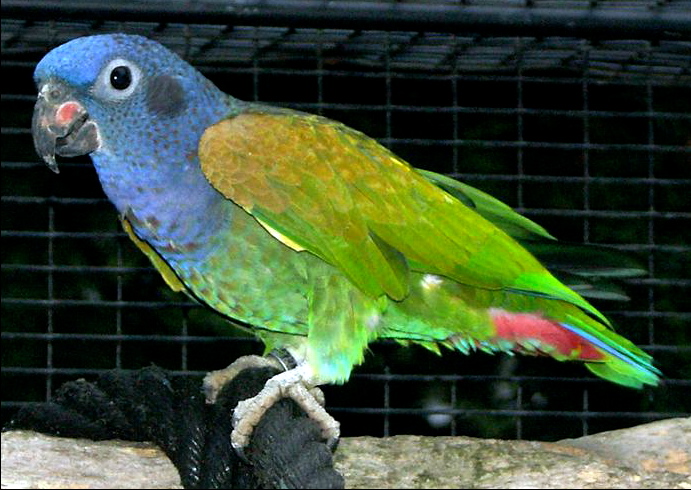
Blue-headed parrot, orBlue-headed pionus(Pionus menstruus)
Phylum —chordata
Class — aves
Order — psittaciformes
Family — psittacidae
Genus – pionus
Appearance
The Blue-headed parrot is about 28 cm (11 in) long and weighs 245 g. It is mainly green with a blue head, neck and upper breast, red undertail coverts, and some yellowish on the wing coverts. The upper mandible is black with reddish areas on both sides. They have dark ear patches.
Habitat
It is a resident in tropical and subtropical South America and southern Central America, from Costa Rica, Venezuela and Trinidad south to Bolivia and Brazil.
Behavior
Blue-headed parrots are noisy birds and make light, high-pitched squeaking sweenk calls. They roost communally in palm and other trees, and large numbers can be seen at the roost sites at dawn and dusk.
Diet
Blue-headed parrots eat fruit and seeds, and sometimes grain.
Reproduction
The Blue-headed parrot nests in tree cavities. The eggs are white and there are usually three to five in a clutch. The female incubates the eggs for about 26 days and the chicks leave the nest about 70 days after hatching.
In captivity
They live up to 35-45 years in captivity.
Beautiful and loving, the Blue-headed pionus has enjoyed great popularity as a pet for many years, and it seems that this trend is not in danger of diminishing. While they are charming, easygoing birds, it cannot be stressed enough that they are not the best pets for everybody. If you are thinking about adopting a Blue-headed pionus, you should definitely do plenty of research to make sure that your lifestyle is suited to caring for one of these birds.
Pionus parrots are very active, and they need lots of room to play and exercise each day. That said, anyone who is interested in owning one of these birds should make sure that they have time in their schedules to give their pets 3 to 4 hours outside of the cage per day, at a minimum. This out of cage playtime should be strictly supervised and should occur in a bird-proof area as pionus are very curious and could get into an accident if left to their own devices.
Like all parrots, ample attention should be paid to the nutritional content of the Blue-headed pionus' diet. In captivity, these birds tend to do best when they are fed a high quality commercial pelleted diet, supplemented with a seed mix formulated for large birds. These foods should always be served in conjunction with a variety of fresh bird-safe fruits and vegetables to ensure that they are getting the proper amounts of vitamins. These parrots also normally enjoy a variety of homemade bird treats such as bird bread recipes, sprouts, and other nutritious creations.
 Russian
Russian
 English
English























